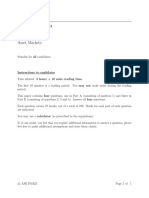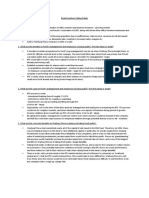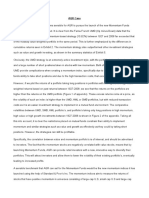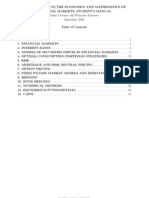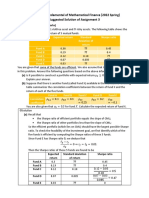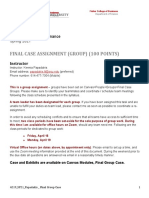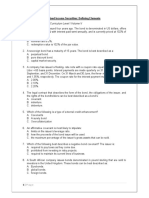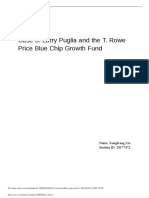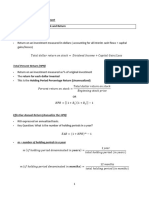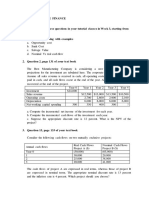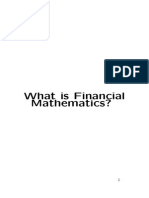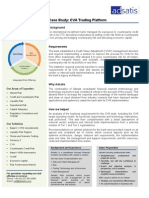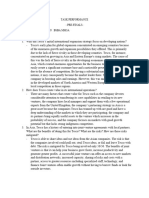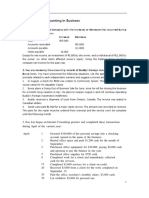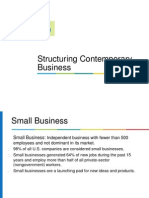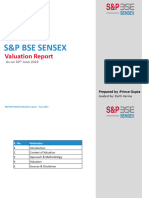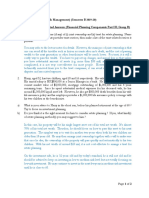Practice Final Exam I
FM423
Asset Markets
Suitable for all candidates
Instructions to candidates
Time allowed: 3 hours + 10 mins reading time.
The first 10 minutes is a reading period. You may not make notes during the reading
period.
This paper contains four questions, one in Part A (consisting of question 1) and three in
Part B (consisting of questions 2, 3 and 4). Answer all four questions.
Each question carries 25 marks, out of a total of 100. Marks for each part of each question
are indicated.
You may use a calculator (as prescribed in the regulations).
If, at any point, you feel that you require additional information to answer a question, please
feel free to make additional assumptions and state them clearly.
c LSE FM423 Page 1 of 8
�Part B
Question 2. (25 marks)
(a) Consider the two (excess return) one-factor-model regression results for stock A and B.
The risk-free rate over the period was 6%, and the market’s average return was 14%.
Performance is measured using a market-factor model regression on excess returns.
Stock A Stock B
One-factor model regression estimates 1%+1.2(rm − rf ) 2%+0.8(rm − rf )
Residual standard deviation, σ(e) 10.5% 19.4%
Standard deviation of excess return 21.4% 25.5%
(i) (4 marks) Calculate the following statistics for each stock: alpha, appraisal ratio,
Sharpe ratio, and Treynor ratio.
(ii) Which stock is the best choice under the following circumstances and why?
i. (2 marks) This is the only risky asset to be held by the investor.
ii. (2 marks) This stock will be mixed with the rest of the investor’s portfolio,
currently composed solely of holdings in the market index fund. This stock’s
weight in the resulting portfolio is large in relation to the weights of the stocks
in the market portfolio.
iii. (2 marks) This is one of many stocks that the investor is analyzing to form
an actively managed stock portfolio.
(iii) (3 marks) You are asked to construct a portfolio that invests exclusively in stocks
A and B. Moreover, the return of this portfolio should be uncorrelated with the
market return (that is, the beta of the portfolio is zero). Give the weights of
such a portfolio and compute its alpha and its Sharpe ratio assuming that the
idiosyncratic risks of A and B are independent.
(b) Give brief answers to the following questions:
(i) (2 marks) What are the main assumptions and the logic of APT?
(ii) (2 marks) What are the advantages and disadvantages of APT relative to the
CAPM?
(iii) (2 marks) Does behavioral finance dispute any of the following statements? Why?
i. No investment strategy can earn excess risk-adjusted returns greater than
what are warranted for its risk level.
ii. Market prices are equal to the fundamental value of the asset (prices are set
by rational agents).
c LSE FM423 Page 2 of 8
� (iv) (2 marks) As discussed in the lectures, noise trader risk is an important deterrent
to arbitrage activity. What are the main assumptions behind noise trader risk?
(c) (4 marks) Consider a forward contract to buy GBP with USD in T years. Let S denote
the GBP/USD spot exchange rate (i.e., $1 = £S); F denote the forward price of GBP
(i.e., $1 = £F ); rU K and rU S denote the annualized T-year risk-free rates in the UK
and the US. Derive F as a function of S, rU K and rU S .
c LSE FM423 Page 3 of 8
�Question 3. (25 marks)
(a) Consider a two-period binomial model (t = {0, 1, 2}), with a risky non-dividend paying
stock and a risk-free bank account. Assume that the price of the stock is now S0 =
£100 and in the first period it can go up by 20% or down by 10% (so u = 1.2 and
d = 0.9). The physical probability that the stock moves up is 0.6. The same behaviour
is exhibited also in the second period. The risk-free rate is r1 = 2% in the first period,
and r2 = 5% in the second period (so that £1 deposited in the bank at t = 0 will be
£1.02 at t = 1, and £1.02 × 1.05 = £1.071 at t = 2).
(i) (4 marks) What is the price at t = 0 of a European call option on the stock with
maturity at t = 2 and strike price K = 110. Does the price at t = 0 change if the
call option is American? Explain.
(ii) (4 marks) What is the price at t = 0 of a European put option on the stock with
maturity at t = 2 and strike price K = 110. Does the price at t = 0 change if the
put option is American? Explain.
(iii) (4 marks) What is the price at t = 0 of an Average Strike Asian call option on
the stock with maturity at t = 2. The payoff at maturity is [ST − Save ]+ where
Save is the average price the stock reaches during the life of the option. An Asian
call option can be only exercised at maturity.
(b) Now consider a stock with Geometric Brownian motion dynamics as in the Black &
Scholes model:
dSt
= µdt + σdWt ,
St
µ and σ are positive known constants. There is also a money-market account with
dynamics
dBt
= rdt,
Bt
where r is a positive known constant.
(i) (4 marks) What is the sign of ρ (i.e., the sensitivity of the price with respect to
r) and ν (i.e., the sensitivity of the price with respect to σ) for a European call
and for a European put in the Black & Scholes model? Explain.
(ii) (4 marks) Consider a stock where µ = 10% and σ = 20%. The current stock price
is £100. What is the probability that a European call option on the stock with
a strike price of £120 and an expiration date in 3 years will be exercised? Leave
your answer in term of the standard normal cumulative distribution function, Φ.
c LSE FM423 Page 4 of 8
� (iii) (5 marks) Consider a derivative that at maturity date T has a payoff of ST10 , i.e.
the 10th power of the stock price at maturity. Derive the price of this derivative
at t = 0, using the risk-neutral valuation method.
c LSE FM423 Page 5 of 8
�Question 4. (25 points)
In this question you are first asked to prove two no arbitrage restrictions. All options are
written on the same non-dividend paying stock, have the same strike price K, and have the
same maturity T . [Notes: Make sure every step in your proof is justified.]
(i) (2 points) CtEU = PtEU + St − PVTt (K) (i.e., Put-Call Parity),
(ii) (3 points) CtAM > St −K (i.e., early exercise of an American call option is never optimal
on a non-dividend paying stock),
for all 0 ≤ t < T , where the subscript t denotes the time at which the corresponding
option/stock price is quoted; the superscripts AM, EU denote that the corresponding option
is American, European. PVTt (·) is the present value operator bringing money risk-free from
T to t.
(iii) (2 points) Discuss whether (ii) can be generalized for American call options on com-
modities. Explain your answer in terms of whether a commodity is in contango or
backwardation.
(iv) (3 points) Now, assume that the financial stock in (ii) pays dividends. The (risk-free)
value of dividends at T for someone who bought the stock at t < T is Dt > 0. Find a
sufficient condition between K and Dt so that the inequality in (ii) still holds.
(v) (5 points) An asset-or-nothing digital call option with strike price K and maturity date
T has payoff ST if ST > K, and 0 otherwise, where ST is the price of the underlying at
maturity. Price this option for strike price 60 and time-to-maturity 2 years, assuming
that the price of the underlying evolves according to the binomial tree in Figure 1
below (one binomial step per year; the numbers along the branches are the physical
probabilities of an up/down move of the price), and the riskfree interest rate is 10%
per annum, compounded annually.
c LSE FM423 Page 6 of 8
�(vi) (3 points) Suppose that the interest rate is constant. Show that the no-arbitrage
forward price is the risk-neutral expectation of the price of the underlying at maturity,
i.e.,
Ft = EQt (ST ),
where Ft is the forward price, ST is the price of the underlying at maturity, and Q is
the risk-neutral probability. Do not use the no-arbitrage formula of the forward price
derived in the lecture.
(vii) (7 points) A US bank’s position in options on the dollar/euro exchange rate has a delta
of 30,000 and a gamma of -80,000.
(a) Explain how these numbers can be interpreted. Are they consistent with a position
in a plain vanilla option?
(b) The exchange rate (dollars per euro) is 0.90. What position should the US bank
take in the spot foreign exchange market to make the overall position delta-
neutral?
(c) After a short period of time, the euro appreciates to $0.93. Estimate the new
delta. What additional trade is necessary to keep the position delta-neutral?
c LSE FM423 Page 7 of 8
� Useful facts [Note: You may use these facts without proof, unless specifically requested
to prove the fact in question.]
• Geometric Brownian Motion
Let Itô process X satisfy the following equation
dXt = αXt dt + βXt dWt ,
where α and β are known constants, and W is standard Brownian Motion. Then given
the value of the process at time t, Xt , we have for all T > t > 0,
�� � �
1 2
XT = Xt exp α − β (T − t) + β(WT − Wt ) .
2
• Itô’s Lemma
Let X be an Itô process with
dXt = M (t, Xt )dt + Σ(t, Xt )dWt ,
where M (·, ·), Σ(·, ·) are smooth functions, and W is a standard Brownian Motion.
Define a new process Zt = g(Xt , t), where g(·, ·) is also a smooth function. Then,
∂g ∂g 1 ∂ 2g
dZt = dt + dXt + [dXt ]2 ,
∂t ∂x 2 ∂x2
or
1
dZt = gt dt + gx dXt + gxx [dXt ]2 .
2
or
� �
1 2
dZt = gt + gx M (t, Xt ) + gxx Σ(t, Xt ) dt + gx Σ(t, Xt )dWt
2
• Log-normal variables
Let Z be a normal random variable with mean m and variance s2 , i.e., Z ∼ N (m, s2 ),
then (where a and b are known constants),
� �
1 2 2
E[exp(a + bZ)] = exp a + bm + b s .
2
• Put-Call Parity
We have that
CtEU = PtEU + St − PVTt (K),
where CtEU , PtEU are the prices at time t (0 ≤ t < T ) of a European call option and a
European put option, respectively, that expire at time T ; St is the stock price at time
t of a non-dividend paying stock; K is the common strike price of the call and the put,
and the PVTt (·) operator is between t and T .
c LSE FM423 Page 8 of 8



